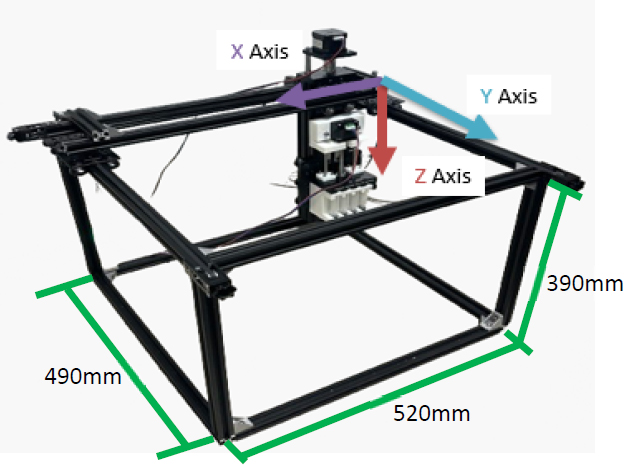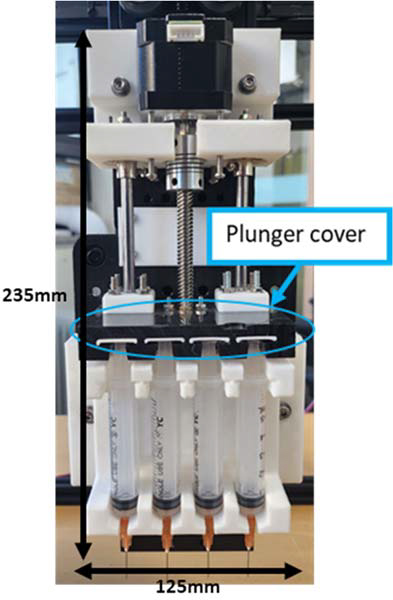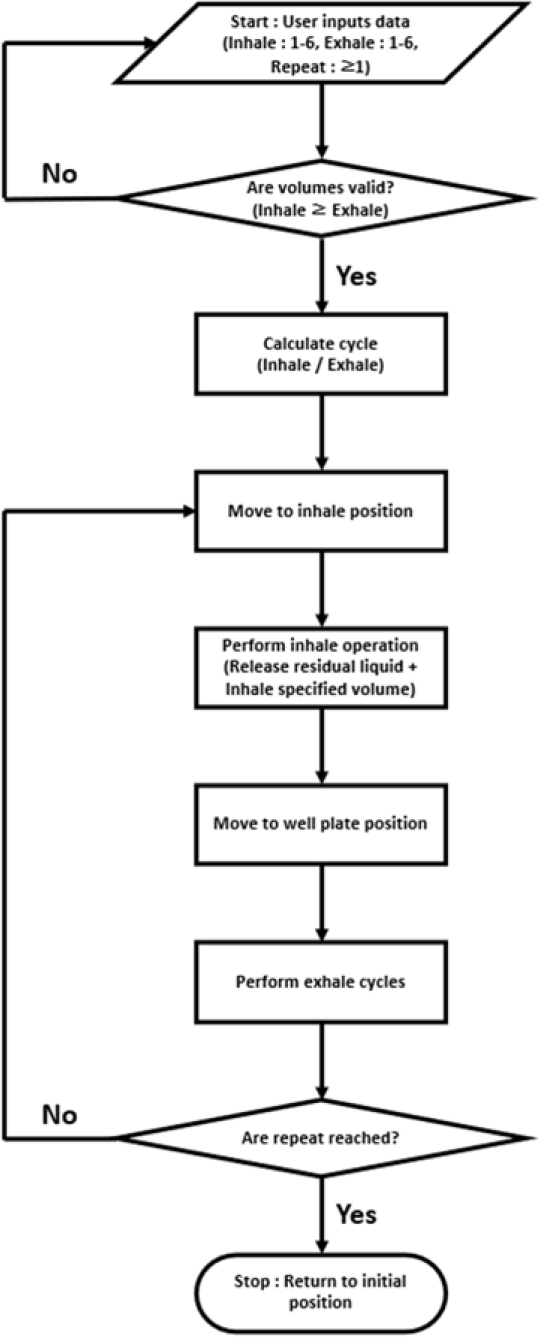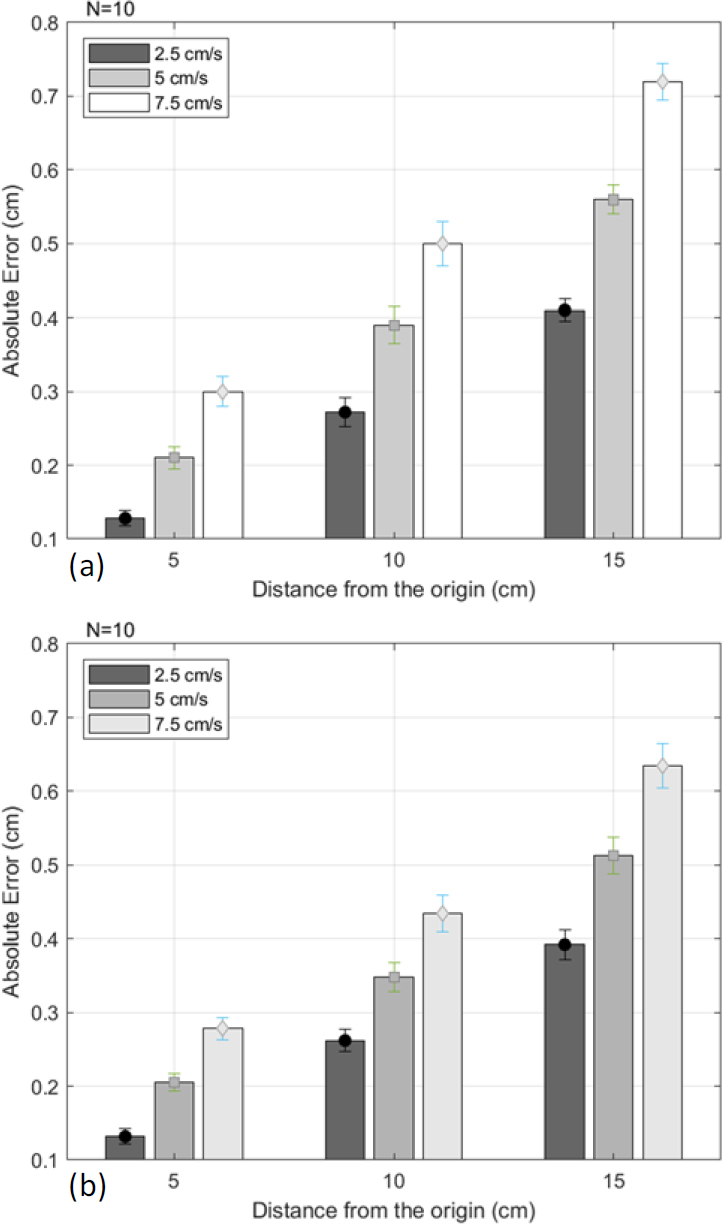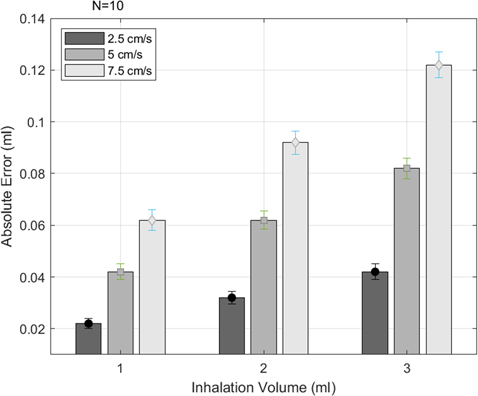
Development of the automatic multi-pipette system using CNC Machine
Copyright © The Korean Society of Marine Engineering
This is an Open Access article distributed under the terms of the Creative Commons Attribution Non-Commercial License (http://creativecommons.org/licenses/by-nc/3.0), which permits unrestricted non-commercial use, distribution, and reproduction in any medium, provided the original work is properly cited.
Abstract
This study presents the development of an automated multi-pipetting system integrated with a computer numerical control (CNC) machine, designed to address the challenges of manual liquid handling in laboratories. Manual pipetting, a widely used method, suffers from inconsistencies, physical strain, and limited scalability, particularly in high-throughput applications. Previous studies have highlighted these issues, emphasizing the need for automation to improve precision, reduce human error, and handle large volumes efficiently. The proposed system leverages direct displacement pipetting technology, which eliminates the variability associated with air displacement methods, providing improved precision and reduced contamination risks. The system's innovative integration of a CNC machine enables precise three-axis motion control, supporting the automated execution of repetitive liquid handling tasks. Four syringe-based pipettes operate simultaneously, ensuring uniform pressure and volume across channels. A user-friendly graphical interface allows customization of workflows, enhancing flexibility and reducing manual intervention. Experimental validation demonstrated low error rates in both position accuracy (3% on the X-axis, 2.7% on the Y-axis) and liquid handling precision (1.4% average inhalation error). This system offers a cost-effective solution, utilizing affordable components such as syringe pistons and stepper motors, making it accessible to resource-limited laboratories and educational institutions.
Keywords:
Multi-Pipette, Automated Pipetting, CNC machine, Inhalation1. Introduction
The COVID-19 pandemic, caused by the Severe Acute Respiratory Syndrome Coronavirus 2 (SARS-CoV-2), has profoundly impacted global health systems, economies, and daily life. With over 100 million confirmed cases and the virus continuing to mutate into more transmissible or immune-evasive variants, the demand for efficient diagnostic testing solutions is critical [1]. Diagnostic testing, which plays a pivotal role in monitoring and containing the spread of infectious diseases, requires accuracy, consistency, and scalability [2]. However, traditional methods often rely on manual operations, presenting challenges in terms of speed, precision, and repeatability. These limitations have underscored the importance of automation in laboratory procedures, particularly in liquid handling, which is essential for a wide range of biological and chemical experiments [3]. This study is designed to meet the need to develop accurate and highly efficient liquid handling systems demanded by the pandemic.
Manual pipetting is a standard technique for liquid handling in laboratories, requiring experimenters to transfer small volumes of liquid with precision using thumb-operated devices. While effective for many applications, manual pipetting has several limitations. Repetitive actions lead to variability in the volume dispensed, and prolonged use often results in physical strain, such as hand fatigue and shoulder discomfort [4, 5]. These issues are exacerbated in high-throughput tasks, such as the preparation of diagnostic samples or multi-well plate experiments, where the demand for speed and accuracy cannot be consistently met through manual efforts. Furthermore, human involvement increases the likelihood of error, particularly when handling reactive or sensitive liquids [3, 4]. To address these challenges, automated pipetting systems have been developed to improve both the accuracy and efficiency of liquid handling.
Among the existing pipetting techniques, air displacement is the most commonly used. This method relies on an air cushion between the piston and the liquid to facilitate transfer. However, the inherent susceptibility of air displacement pipettes to environmental factors, such as temperature and pressure changes, limits their precision. Additionally, the interaction between the air cushion and reactive or volatile liquids can lead to contamination, making this method unsuitable for handling certain sample types. An alternative approach, known as direct displacement pipetting, eliminates the air cushion by allowing the piston to make direct contact with the sample. This method enhances precision and consistency, particularly for complex or sensitive liquids, such as viscous, corrosive, or temperature-sensitive substances. Direct displacement pipetting also reduces the risk of contamination and is better suited for applications requiring stringent quality control [6, 7]. Despite its advantages, most existing direct displacement systems are either cost-prohibitive or lack integration with automated workstations, limiting their accessibility and scalability.
In this study, we introduce an innovative solution to these limitations: an automated multi-pipetting system integrated with a computer numerical control (CNC) machine. By combining the precision of CNC motion control with the reliability of direct displacement pipetting, this system automates repetitive liquid handling tasks with minimal human intervention. The proposed system employs stepper motors to control movement along the X, Y, and Z axes, enabling the precise inhalation and ejection of liquids. Its design supports high-throughput applications, such as filling multiple well plates, with improved accuracy and speed compared to manual methods. The system's core innovation lies in its integration of a multi-channel pipette with a CNC platform. Unlike traditional systems, which are often limited to single-channel or semi-automated operations, our design leverages four syringe pumps operating simultaneously. Each syringe is equipped with a needle-tip pipette to facilitate the precise transfer of liquids. This configuration not only increases throughput but also ensures uniform pressure across all channels, minimizing variability in the volumes dispensed.
There are commercially available multi-channel pipetting machines that offer high accuracy and well-engineered designs. However, these machines are prohibitively expensive, making them difficult to access for schools or laboratories with limited budgets. Additionally, the complex and intricate design of these machines means that even a minor malfunction requires professional repair, which can result in significant downtime. This delay is particularly problematic when experiments need to proceed quickly, as it often necessitates waiting for technical support.
In contrast, the multi-channel automatic pipetting machine developed in this study utilizes commonly available and cost-effective materials, such as step motors, syringe barrels, and profiles. This approach significantly reduces the overall cost, making the machine more accessible to institutions with budget constraints. Despite its lower cost, the machine maintains a high level of performance, offering an affordable yet efficient solution.
Furthermore, the design of our machine emphasizes ease of adjustment and modification. Unlike more complex systems, it can be easily disassembled, allowing users to replace or repair malfunctioning components without requiring external assistance. This simplicity not only enhances the machine's usability but also results in long-term cost savings by reducing the need for expensive repairs and maintenance services.
Moreover, the system incorporates a graphical user interface (GUI) that allows users to program specific tasks, such as inhalation and ejection volumes, through an intuitive interface. Once programmed, the system executes these tasks autonomously, reducing the need for continuous supervision. This system highlights the potential of the system to meet the demands of modern laboratory workflows, particularly in diagnostic and research settings.
In addition to its technical capabilities, the proposed system offers a cost-effective solution for laboratories with limited resources. The use of inexpensive syringe pistons and readily available components ensures a low price without compromising performance. This makes the system suitable for use in advanced research facilities as well as in academic institutions where budget constraints limit access to high-quality laboratory equipment [8].
2. Components of the Current Device
The proposed automated multi-pipetting system is composed of three primary components: the CNC machine, the multi-pipette assembly, and the control algorithm. Each component plays a critical role in ensuring the system’s precision, reliability, and scalability for laboratory applications.
2.1 CNC Machine
The CNC machine serves as the structural and functional backbone of the system, enabling precise three-axis motion (X, Y, Z). Figure 1 as shown in, its rectangular prism framework is constructed using aluminum profiles, ensuring structural stability. This robust design enhances durability and provides a stable platform for liquid handling tasks, particularly in laboratory environments where consistency is critical.
Stepper motors are used to control the motion along each axis. The X-axis supports lateral movement, the Y-axis facilitates forward and backward motion, and the Z-axis enables vertical adjustments. These motors are programmed to operate in coordination, ensuring the multi-pipette reaches the desired position with high precision. Notably, the Y-axis employs dual stepper motors to distribute the load evenly, particularly when handling heavier assemblies.
The X-axis incorporates two supplementary aluminum profiles to support the weight of the actuator and the multi-pipette assembly. This configuration prevents mechanical instability during operation, especially when the system is moving at higher speeds. Additionally, a vertical actuator is mounted on the Z-axis motor, allowing the pipette assembly to approach target positions with micrometer accuracy.
The dimensions of the CNC machine framework are provided in Table 1, demonstrating that it offers sufficient workspace for multi-pipette operations. The performance specifications of the stepper motors used in the CNC machine are also listed in Table 1. These motors ensure high precision, enabling consistent and reliable positioning.
2.2 Multi-Pipette device
The multi-pipette assembly is the core liquid handling component of the system. It employs four syringe-based pipettes, each with a capacity of 6 ml. This configuration allows for simultaneous liquid transfer across multiple channels, significantly enhancing throughput compared to single-channel pipetting systems.
The multi-pipette is mounted on a linear actuator, which translates the rotational motion of a stepper motor into linear displacement. Linear actuator ensures precise pipette movement and maintains uniform pressure in each syringe. The motor drives the plunger cover, which moves the syringe plungers up or down in Figure 2. This motion generates a pressure differential within each syringe, enabling precise inhalation and ejection of liquids. Needle-tipped pipette tips are used to ensure accuracy and compatibility with a variety of sample types.
Unlike traditional air displacement pipettes, the multi-pipette assembly employs a direct displacement method. This eliminates the need for an air cushion, reducing the risk of volume inconsistencies and contamination. This method is particularly advantageous for handling complex samples, such as viscous or reactive liquids, and ensures reliable performance across diverse applications.
The dimensions of the multi-pipette device are specified in Table 1, demonstrating its suitability for liquid handling tasks. The stepper motors employed in this device are identical to those used in the CNC framework, and their performance specifications are also detailed in Table 1. These motors ensure high precision, enabling accurate liquid handling across all channels.
2.3 Control Algorithm
The control algorithm governs the interaction between the CNC machine and the multi-pipette assembly. It enables the system to execute predefined liquid handling tasks autonomously. The algorithm flowchart is shown in Figure 3.
First, the user inputs the inhale volume, exhale volume, and repeat count into the system. The inhale and exhale volumes must range from 1 to 6 ml, entered in 1 ml increments. If the exhale volume exceeds the inhale volume, it is considered an error, and the system will prompt the user to re-enter the values. The repeat count must be an integer greater than or equal to 1. The system calculates the amount to be distributed to each well plate based on the input inhale and exhale volumes. It then moves to the inhale position, expels any residual liquid inside the syringe, and intakes the specified volume. Subsequently, the system moves to the well plate position and dispenses the calculated volume into each well. After completing the operation for the specified number of repeats, the multi-pipette assembly returns to its initial position and stops functioning.
3. Methodology
3.1 Position Accuracy Experiment
This experiment was conducted to measure the accuracy of the pipette's movement to the target positions. A grid paper with 1 cm intervals was used for the experiment, and a laser pointer was employed to indicate the current position. The pipette moved from the origin to the target point along the X and Y axes, and the position indicated by the laser was recorded. The target distances were set at 5 cm, 10 cm, and 15 cm from the origin. Considering that the well plate used in this device has a length of 12.5 cm and the distance from the origin to the well plate, the maximum distance was set to 15 cm. The purpose of this experiment was to assess the accuracy of the pipette's movement within a specific range.
At each target distance, 10 repeated measurements were performed, and three different speeds—2.5 cm/s, 5 cm/s, and 7.5 cm/s—were applied. In laboratory work environments, lower speeds are more suitable for precise tasks, while higher speeds are advantageous for handling large volumes. The minimum speed of 2.5 cm/s was chosen as the most efficient for precision tasks among the lower speeds. As the speed increases, mechanical errors may become more significant, so the maximum speed was set at 7.5 cm/s. The average error value was calculated by averaging the 10 error values obtained for each condition.
3.2 Pipette Inhalation Accuracy Experiment
This experiment was conducted to verify the accuracy of simultaneous inhalation by four pipettes. The method involved measuring the weight after inhalation, which is a critical factor in ensuring that the pipette system can achieve consistent inhaled volumes. This is particularly important in biological and chemical analyses, where tasks such as parallel sample preparation are fundamental. The liquid used in the experiment was water, and a scale with an accuracy of 0.1g was employed. Since the density of water is approximately 1 at both 4°C and 15°C, the measurement of 1g corresponds to 1 ml, which does not affect the results of the experiment. A beaker filled with water was placed on the scale, and the four pipettes simultaneously inhaled water. The deviation in the inhalation volume was recorded. The experiment was performed for three different inhalation volumes (1 ml, 2 ml, and 3 ml), and each test was repeated 10 times. The inhalation volume variable was based on the amount inhaled by each pipette. Since four pipettes inhale simultaneously, the total inhalation volume should be four times the individual pipette’s inhaled volume. Three different speeds—2.5 m/s, 5 m/s, and 7.5 m/s—were applied to each inhalation volume condition. The average error rate was calculated by averaging the 10 error values obtained for each condition.
4. Experimental Results
4.1 Position Accuracy
The position accuracy experiment assessed the CNC machine's ability to move the pipette assembly to predefined target positions along the X, Y, and Z axes. Measurements were taken at three target distances (5 cm, 10 cm, and 15 cm) and three stepper motor speeds (2.5 cm/s, 5 cm/s, and 7.5 cm/s).
The experimental results showed that error rates increased with both distance and speed. For the X-axis, the error rates were lowest at 5 cm and 2.5 cm/s, averaging 1.2%, while the highest error of 3% was observed at 15 cm and 7.5 cm/s. Similar trends were noted for the Y-axis, with error rates ranging from 1.1% to 2.7%. These results demonstrate the system’s high precision at shorter distances and lower speeds, making it suitable for tasks requiring fine control, such as filling adjacent wells in a plate.
For the Z-axis, the error rates were consistently below 1% across all conditions, highlighting the reliability of the vertical motion actuator. This is particularly important for ensuring that the pipette tips reach the correct depth for liquid handling tasks, minimizing the risk of sample contamination or incomplete ejection.
While higher speeds are advantageous for high-throughput tasks, they introduce mechanical vibrations and dynamic errors, resulting in reduced accuracy. Thus, selecting an appropriate speed based on the task's precision requirements is crucial.
These findings suggest that the system is well-suited for applications requiring precise positioning, such as reagent distribution in diagnostic tests. However, for ultra-precise tasks, lower speeds are recommended to minimize errors.
4.2 Pipette Inhalation Accuracy
The pipette inhalation accuracy experiment evaluated the system’s ability to maintain consistent volumes across all four channels. Each channel inhaled water volumes of 1 ml, 2 ml, and 3 ml at three different speeds. The error rates for inhalation volumes were low across all conditions, with an overall average of 1.4%. However, larger volumes and higher speeds resulted in slightly higher deviations. At 1 ml and 2.5 cm/s, the error rate was 0.8%. At 3 ml and 7.5 cm/s, the error rate increased to 2.1%.
These results indicate that the system maintains high accuracy for small to moderate volumes, even at higher speeds. However, larger volumes require more careful calibration, especially in high-speed operations, to maintain uniform pressure across all syringes. One of the system’s key strengths is its ability to ensure uniform liquid handling across all four pipettes. The deviations between channels were minimal (less than 0.5% for all conditions), demonstrating the system’s potential for parallel sample preparation in high-throughput experiments.
4.3 Combined Performance Evaluation
The combined analysis of position accuracy and inhalation accuracy highlights the system’s ability to balance precision and efficiency. While error rates increase at higher speeds and larger volumes, they remain within acceptable ranges for most laboratory applications. These results validate the system's capability to handle diverse liquid handling tasks with minimal supervision. Further refinements in motor synchronization and syringe calibration could reduce error rates, enabling the system to perform ultra-precise tasks, such as handling micro-liter volumes for advanced research applications.
5. Conclusion
The proposed automated multi-pipetting system offers a novel solution to the challenges of manual liquid handling in laboratory environments. By integrating direct displacement pipetting with CNC motion control, the system addresses key limitations of existing methods, such as inconsistency, physical strain, and limited scalability.
The system demonstrated high accuracy in both positioning and liquid handling tasks, with error rates of 3%, 2.7% and 1.4%, respectively. This ensures reliable performance for a wide range of applications, including diagnostic testing and chemical analysis. The multi-channel design significantly increases throughput, enabling simultaneous liquid handling across four channels. This reduces processing time and minimizes human intervention, making the system ideal for high-throughput workflows. The use of low-cost components, such as syringe pistons and stepper motors, ensures affordability without compromising performance. This makes the system accessible to educational institutions and research facilities with limited budgets. The system’s compatibility with diverse sample types, including viscous, reactive, and temperature-sensitive liquids, enhances its applicability across various scientific fields.
An already developed automated multi-pipetting machine exists, and its main advantages lie in its advanced features and automated processes that greatly enhance the efficiency of experiments. In particular, this machine can automatically replace pipette tips, ensuring hygienic use, and can precisely control liquids at the micro-liter level, enabling accurate experiments. Additionally, its advanced design and technology minimize the user's workload, automating repetitive tasks and reducing experiment time.
However, this automated multi-pipetting machine is designed with a complex internal system, making it difficult for users to understand and repair. Even a minor malfunction requires waiting for a technician, leading to significant delays in time-sensitive experiments. Despite its high cost, which aims to speed up processes, even small issues can cause substantial downtime. In contrast, the machine developed in this study has a simpler design, allowing users to easily disassemble it and replace damaged parts, thus minimizing delays. It is also more affordable, making it accessible to schools and laboratories with limited budgets. However, while the automated multi-pipetting machine can automatically replace pipette tips for hygienic use, the developed machine does not use pipette tips and requires the syringe to be replaced after each experiment, which can be inconvenient. Additionally, while the automated multi-pipetting machine can handle liquids at a micro-liter level, the developed machine operates at a milliliter scale. This comparison highlights the trade-off between functionality, cost, and ease of maintenance, suggesting that for laboratories with budget constraints, the simpler machine may be a more practical option despite certain limitations in precision and convenience.
The developed machine has strengths, but there are several limitations that require further investigation. While the error rates are acceptable for most tasks, further optimization of motor synchronization and motion algorithms could enhance performance, particularly in ultra-precise applications. The current design is not optimized for handling micro-liter volumes, and future research will explore improvements in syringe design and control mechanisms to allow for more accurate handling of smaller volumes. Furthermore, integrating advanced sensors for real-time feedback and error correction could improve system reliability and user convenience. Expanding the GUI’s functionality to support more complex workflows would also increase user flexibility.
This study presents a robust, cost-effective automated pipetting system capable of improving laboratory workflows by reducing human error, increasing throughput, and enhancing precision. Its potential applications range from routine diagnostic tests to advanced research experiments, making it a valuable tool for modern laboratories. With further refinements, the system could become a cornerstone of laboratory automation, providing researchers with a reliable "third arm" for liquid handling tasks.
Acknowledgments
This work was supported by the Regional Industry-linked University Open-Lab Promotion Support Project and the KMOU Academic research fund in 2024.
Author Contributions
Conceptualization, M. Kang, M. Kim, I. Kim and J. Ko; Methodology, M. Kang and M. Kim; Software, M. Kang and M. Kim; Validation, I. Kim and J. Ko; Formal Analysis, M. Kang, M. Kim, I. Kim and J. Ko; Investigation, M. Kang and M. Kim; Resources, J. Ko; Data Curation, M. Kang and M. Kim; Writing - preparation of the original draft, M. Kang and M. Kim; Writing - reviewing and editing, I. Kim and J. Ko; Visualization, M. Kang and M. Kim; Supervision, J. Ko; Project Management, J. Ko; Funding, J. Ko.
References
-
W. Zhou and W. Wang, “Fast-spreading SARS-CoV-2 variants: challenges to and new design strategies of COVID-19 vaccines,” Signal Transduction and Targeted Therapy, vol. 6, no. 226, 2021.
[https://doi.org/10.1038/s41392-021-00644-x]

-
J. Whitworth, “COVID-19: a fast evolving pandemic,” Transactions of the Royal Society of Tropical Medicine and Hygiene, vol. 114, no. 4, pp. 241-248, 2020.
[https://doi.org/10.1093/trstmh/traa025]

-
G. Lippi, G. Lima-Oliveira, G. Brocco, A. Bassi, and G. L. Salvagno, “Estimating the intra- and inter-individual imprecision of manual pipetting,” Clinical Chemistry and Laboratory Medicine, vol. 55, no. 7, 2016.
[https://doi.org/10.1515/cclm-2016-0810]

-
M. G. Bjorksten, B. Almby, and E. S. Jansson, “Hand and shoulder ailments among laboratory technicians using modern plunger-operated pipettes,” Applied Ergonomics, vol. 25, no. 2, pp. 88-94, 1994.
[https://doi.org/10.1016/0003-6870(94)90069-8]

-
J. Z. Wu, E. W. Sinsel, J. F. Shroyer, C. M. Warren, D. E. Welcome, K. D. Zhao, K. N. An, and F.L. Buczek, “Analysis of the musculoskeletal loading of the thumb during pipetting – A pilot study,” Journal of Biomechanics, vol. 47, no. 2, pp. 392-399, 2014.
[https://doi.org/10.1016/j.jbiomech.2013.11.015]

-
C. Schuster, K. Habler, and M. Vogeser, “Effect of gravimetric correction and type of pipettes used in sample preparation on the precision of LC–MS/MS-based analyses,” Clinical Biochemistry, vol. 91, pp. 63-66, 2021.
[https://doi.org/10.1016/j.clinbiochem.2021.01.017]

-
X. Zhao, Z. Yuan, L. Lin, C. Zheng, and H. You, “Development of a new lightweight multi-channel micro-pipette device,” Machines, vol. 12, no. 6, 359, 2024.
[https://doi.org/10.3390/machines12060359]

-
S. B. Boesdorfer and R. A. Livermore, “Secondary school chemistry teacher's current use of laboratory activities and the impact of expense on their laboratory choices,” Chemistry Education Research and Practice, vol. 19, pp. 135-148, 2018.
[https://doi.org/10.1039/C7RP00159B]


